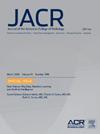Growth in Nonprocedural Services and Market Dynamics: The Changing Landscape of Interventional Radiology
IF 5.1
3区 医学
Q1 RADIOLOGY, NUCLEAR MEDICINE & MEDICAL IMAGING
引用次数: 0
Abstract
Objective
To evaluate the evolution of interventional radiology (IR) practice patterns from 2013 to 2022, focusing on longitudinal growth in evaluation and management (E&M) services among actively practicing IR physicians.
Methods
Using the Medicare Physician and Other Supplier Public Use File, we retrospectively identified “actively practicing IR physicians” based on a minimum 10% threshold of annual procedural and clinical work relative value units derived from IR-specific procedural codes. For each calendar year, we tallied the number of actively practicing IR physicians, total E&M claims, and mean E&M claims per IR physician. A two-step decomposition was then performed to quantify how much of the change in total E&M services was attributable to fluctuations in physician count versus changes in per-physician E&M billing.
Results
From 2013 to 2022, total E&M claims rose from 149,481 to 201,825 (+52,344, +35.0%, P < .05). The number of IR physicians billing ≥11 E&M claims per annum rose 12.9% from 1,347 in 2013 to 1,522 in 2022. Mean E&M claims per clinically active IR physician increased 19.8% from 111 to 133 (P < .05). The number of actively practicing IR physicians declined from 12,483 in 2013 to 11,585 in 2022 (−7.2%). Decomposition analysis revealed that, absent the drop in IR physician count, E&M claims would have been higher by 10,776. However, an additional 62,559 E&M services stemming from increased per-physician billing offset this effect, yielding a net growth of approximately 52,000 E&M claims.
Conclusion
IR physicians markedly expanded their E&M activities during the past decade. This growth is primarily driven by a rising fraction of “active-clinical” IRs who are growing in number and intensifying their clinical workload. These findings underscore IR’s accelerating transition toward comprehensive patient care, with significant implications for training, practice management, and the specialty’s role within the broader health care landscape.
介入放射学的变化:非程序性服务和市场动态的增长。
目的:评估2013 - 2022年介入放射学(IR)执业模式的演变,重点关注介入放射学执业医师在评估与管理(E&M)服务方面的纵向增长。方法:使用医疗保险医师和其他供应商公共使用文件,我们根据来自IR特定程序代码的年度程序和临床工作相对价值单位的最低10%阈值,回顾性地确定“积极执业IR医生”。对于每个日历年,我们统计了活跃执业IR医生的数量、E&M索赔总额和每位IR医生的平均E&M索赔。然后进行两步分解,以量化总医疗服务中有多少变化可归因于医生数量的波动与每位医生医疗服务账单的变化。结果:从2013年到2022年,E&M索赔总量从149,481件增加到201,825件(+52,344件,+35.0%,P < 0.05)。每年进行≥11次机电索赔的IR医生数量从2013年的1347人增加到2022年的1522人,增长了12.9%。每位临床活跃IR医生的平均E&M索赔从111增加到133,增加了19.8% (P < 0.05)。活跃执业IR医生的数量从2013年的12483人下降到2022年的11585人(-7.2%)。分解分析显示,如果没有IR医生数量的下降,E&M索赔将高出10,776。但是,由于每名医生收费增加,额外增加了62,559项机电服务,抵消了这一影响,产生了大约52,000项机电索赔的净增长。结论:在过去的十年中,IR医生明显扩大了他们的E&M活动。这种增长主要是由越来越多的“活跃临床”注册会计师推动的,他们的数量不断增加,临床工作量也越来越大。这些发现强调了IR正在加速向全面的患者护理过渡,这对培训、实践管理以及该专业在更广泛的医疗保健领域中的作用具有重要意义。
本文章由计算机程序翻译,如有差异,请以英文原文为准。
求助全文
约1分钟内获得全文
求助全文
来源期刊

Journal of the American College of Radiology
RADIOLOGY, NUCLEAR MEDICINE & MEDICAL IMAGING-
CiteScore
6.30
自引率
8.90%
发文量
312
审稿时长
34 days
期刊介绍:
The official journal of the American College of Radiology, JACR informs its readers of timely, pertinent, and important topics affecting the practice of diagnostic radiologists, interventional radiologists, medical physicists, and radiation oncologists. In so doing, JACR improves their practices and helps optimize their role in the health care system. By providing a forum for informative, well-written articles on health policy, clinical practice, practice management, data science, and education, JACR engages readers in a dialogue that ultimately benefits patient care.
 求助内容:
求助内容: 应助结果提醒方式:
应助结果提醒方式:


